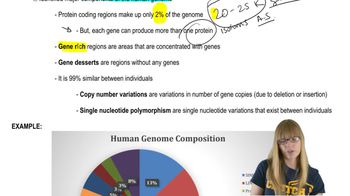A group of families in which an autosomal dominant condition is present are studied to determine lod scores for possible genetic linkage between three RFLP markers (R1, R2, and R3) and the disease gene. The chart shows lod scores at each of the recombination distances (θ values) tested. Provide an interpretation of the lod score results for each RFLP. Be specific about any significant evidence of genetic linkage.
Table of contents
- 1. Introduction to Genetics51m
- 2. Mendel's Laws of Inheritance3h 37m
- 3. Extensions to Mendelian Inheritance2h 41m
- 4. Genetic Mapping and Linkage2h 28m
- 5. Genetics of Bacteria and Viruses1h 21m
- 6. Chromosomal Variation1h 48m
- 7. DNA and Chromosome Structure56m
- 8. DNA Replication1h 10m
- 9. Mitosis and Meiosis1h 34m
- 10. Transcription1h 0m
- 11. Translation58m
- 12. Gene Regulation in Prokaryotes1h 19m
- 13. Gene Regulation in Eukaryotes44m
- 14. Genetic Control of Development44m
- 15. Genomes and Genomics1h 50m
- 16. Transposable Elements47m
- 17. Mutation, Repair, and Recombination1h 6m
- 18. Molecular Genetic Tools19m
- 19. Cancer Genetics29m
- 20. Quantitative Genetics1h 26m
- 21. Population Genetics50m
- 22. Evolutionary Genetics29m
4. Genetic Mapping and Linkage
Mapping Genes
Problem 24
Textbook Question
Traditional gene mapping has been applied successfully to a variety of organisms including yeast, fungi, maize, and Drosophila. However, human gene mapping has only recently shared a similar spotlight. What factors have delayed the application of traditional gene-mapping techniques in humans?
 Verified step by step guidance
Verified step by step guidance1
Understand that traditional gene mapping relies on controlled breeding experiments to track the inheritance of genetic traits across generations. This is straightforward in organisms like yeast, fungi, maize, and Drosophila, where researchers can control mating and produce large numbers of offspring in a short time.
Recognize that humans have unique challenges for gene mapping. One major factor is the ethical and practical impossibility of controlled breeding experiments in humans, which limits the ability to study inheritance patterns directly.
Consider the generation time in humans. Humans have a long generation time (approximately 20-30 years), which makes it difficult to study multiple generations in a reasonable timeframe compared to organisms with short life cycles like Drosophila or yeast.
Acknowledge the complexity of the human genome. Humans have a large genome with approximately 3 billion base pairs and a high level of genetic variation, which makes identifying specific genes associated with traits more challenging.
Factor in the smaller family sizes in humans compared to model organisms. Smaller family sizes reduce the statistical power to detect linkage between genetic markers and traits, making traditional gene mapping less effective in humans.
 Verified video answer for a similar problem:
Verified video answer for a similar problem:This video solution was recommended by our tutors as helpful for the problem above
Video duration:
3mPlay a video:
Was this helpful?
Key Concepts
Here are the essential concepts you must grasp in order to answer the question correctly.
Complexity of Human Genetics
Human genetics is inherently more complex than that of model organisms like yeast or Drosophila. Humans have a larger genome with more genes, and the interactions between these genes can be influenced by environmental factors, making it challenging to map traits accurately.
Recommended video:
Guided course

Human Genome Composition
Ethical Considerations
The study of human genetics raises significant ethical concerns, including issues of privacy, consent, and potential discrimination. These ethical considerations have led to stricter regulations and a more cautious approach in applying traditional gene-mapping techniques to human subjects.
Recommended video:
Guided course

Mapping with Markers
Technological Limitations
Historically, the technology available for gene mapping in humans was less advanced than that used for other organisms. Techniques such as DNA sequencing and genetic markers have only recently become sophisticated enough to allow for effective mapping of human genes, contributing to delays in research.
Recommended video:
Guided course

Sex-Linked Genes
Related Videos
Related Practice
Textbook Question
368
views


